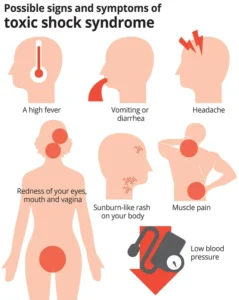It was an ordinary day for Emily, just like any other, when she went about her usual routine. She had been using tampons for years and had always considered it a simple, practical way to manage her period. But everything changed one night when, unknowingly, she made a mistake that would almost cost her life. Emily fell asleep with a tampon in, as many women do, and didn’t think twice about it. Unfortunately, that night she woke up to a serious health scare.

By the morning, she had developed a rash, her body was covered in hives, and she was feeling more unwell than she could explain. Initially, Emily thought it was just an allergic reaction to something she had come into contact with. But as her condition worsened, she visited her doctor again, and this time, the diagnosis was much more serious. The doctor urgently recommended she be hospitalized. Emily was soon diagnosed with Toxic Shock Syndrome (TSS), a rare and life-threatening bacterial infection often associated with tampon use.

What started as an ordinary day turned into an intense battle for Emily’s life. After spending two weeks in the hospital and undergoing multiple treatments, she miraculously recovered. Emily’s close call with TSS was a wake-up call for her — and it could be a warning for all women to be more aware of the risks associated with tampon use and the importance of taking simple precautions to protect their health. What Is Toxic Shock Syndrome (TSS)? Toxic Shock Syndrome (TSS) is a severe bacterial infection caused by toxins produced by the bacteria Staphylococcus aureus or Streptococcus pyogenes. These bacteria can produce toxins that enter the bloodstream and cause a range of harmful effects. While TSS is rare, it is extremely dangerous and can lead to severe complications, including organ failure and even death if not treated promptly. TSS is commonly linked to tampon use, particularly if tampons are left in for extended periods.

How TSS is Linked to Tampon Use Tampons are designed to absorb menstrual blood, but when left in for too long, they can create an environment that encourages bacterial growth. Super-absorbent tampons, in particular, can increase the risk of TSS. These tampons can absorb a lot of fluid, but they also create a situation where bacteria can grow. The bacteria then produce toxins that enter the bloodstream, leading to TSS.
Research suggests that TSS is most common when tampons are left in for extended periods, particularly overnight or for more than the recommended 4-8 hours. While TSS is rare, the risk increases if the proper precautions are not followed. Warning Signs of Toxic Shock Syndrome
It is critical to recognize the symptoms of TSS early to prevent serious complications. TSS can develop very quickly, and early detection is crucial. The symptoms of TSS can resemble those of other illnesses, so it is important for women to be aware of them. Common signs and symptoms of TSS include: High fever: A sudden, intense fever is often the first sign. Rash: The rash may appear similar to sunburn and can cover large portions of the body. Dizziness or fainting: This is due to the toxins causing a drop in blood pressure. Muscle aches: Pain in the muscles is often a symptom of TSS. Nausea and vomiting: These symptoms typically accompany the condition and can make you feel extremely ill. Low blood pressure: Low blood pressure can lead to dizziness, fainting, or shock. If you experience any of these symptoms, especially after using a tampon, you should remove the tampon immediately and seek medical help as soon as possible. How to Prevent Toxic Shock Syndrome (TSS)
The good news is that TSS is preventable. By following simple guidelines, you can significantly reduce your risk of developing this life-threatening condition. The key to prevention lies in proper tampon use, regular changes, and maintaining good hygiene. Here are essential tips to help protect yourself: 1. Use Low Absorbency Tampons
One of the best ways to reduce your risk of TSS is to choose tampons with the lowest absorbency that suits your menstrual flow. Super absorbent tampons can increase the risk of bacterial growth, as they absorb a large amount of fluid and may not be as effective at preventing the growth of harmful bacteria. Opt for the lowest absorbency that matches your needs, especially during lighter days of your period. 2. Change Tampons Regularly


